Differences in Airborne Particulate Matter Concentration in Urban Green Spaces with Different Spatial Structures in Xi’an, China
Abstract
:1. Introduction
- The factors of meteorological parameters, monitoring time, vegetation structure, and vegetation height influencing the concentration of airborne particulate matter;
- The differences in the concentration distribution of airborne particulate matter in urban green spaces with different vegetation structures at different heights.
2. Materials and Methods
2.1. Study Area
2.2. Classification and Selection of Urban Green Spaces
2.3. Field Monitoring
2.4. Statistical Analysis
3. Results
3.1. Effects of the Dominated Factors on Airborne Particulate Matter
3.2. Effects of Meteorological Parameters on Airborne Particulate Matter
3.3. Effects of Diurnal Variation before and after the Heating Period on Airborne Particulate Matter
3.4. Effects of Different Vegetation Structures on the Concentration of Airborne Particulate Matter
4. Discussion
4.1. The Influence of Meteorological Parameters on the Concentration of Airborne Particulate Matter
4.2. The Influence of Time on the Concentration of Airborne Particulate Matter
4.3. The Influence of Vegetation Structure on the Concentration of Airborne Particulate Matter at Different Heights
4.4. Limitations and Future Study
5. Conclusions
Author Contributions
Funding
Institutional Review Board Statement
Informed Consent Statement
Data Availability Statement
Acknowledgments
Conflicts of Interest
References
- Xing, Y.; Brimblecombe, P. Urban park layout and exposure to traffic-derived air pollutants. Landscape Urban Plan 2020, 194, 103682. [Google Scholar] [CrossRef]
- Hu, M.G.; Jia, L.; Wang, J.F.; Pan, Y.P. Spatial and temporal characteristics of particulate matter in Beijing, China using the Empirical Mode Decomposition method. Sci. Total Environ. 2013, 458–460, 70–80. [Google Scholar] [CrossRef] [PubMed]
- He, C.; Qiu, K.Y.; Alahmad, A.; Pott, R. Particulate matter capturing capacity of roadside evergreen vegetation during the winter season. Urban For. Urban Green. 2020, 48, 126510. [Google Scholar] [CrossRef]
- Beckett, K.P.; Freer-Smith, P.H.; Taylor, G. Urban woodlands: Their role in reducing the effects of particulate pollution. Environ. Pollut. 1998, 99, 347–360. [Google Scholar] [CrossRef]
- Li, X.; Wu, J.R.; Elser, M.; Feng, T.; Cao, J.J.; EI-Haddad, I.; Huang, R.; Tie, X.X. Contributions of residential coal combustion to the air quality in Beijing–Tianjin–Hebei (BTH), China: A case study. Atmos. Chem. Phys. 2018, 18, 10675–10691. [Google Scholar] [CrossRef] [Green Version]
- Sawidis, T.; Breuste, J.; Mitrovic, M. Trees as bioindicator of heavy metal pollution in three European cities. Environ. Pollut. 2011, 159, 3560–3570. [Google Scholar] [CrossRef]
- Weber, S.; Litschke, T. Variation of particle concentrations and environmental noise on the urban neighbourhood scale. Atmos. Environ. 2008, 42, 7179–7183. [Google Scholar] [CrossRef]
- Nowak, D.J.; Crane, D.E.; Stevens, J.C. Air pollution removal by urban trees and shrubs in the United States. Urban For. Urban Green. 2006, 4, 115–123. [Google Scholar] [CrossRef]
- Chen, S.J. Effects of plants on atmospheric particulate matter based on simulation experiments. Beijing For. Univ. 2015, 3–10. [Google Scholar]
- Weerakkody, U.; Dover, J.W.; Mitchell, P. The impact of rainfall in remobilising particulate matter accumulated on leaves of four evergreen species grown on a green screen and a living wall. Urban For. Urban Green. 2018, 35, 21–31. [Google Scholar] [CrossRef]
- Guo, W.; Shen, T.Y.J.; Zheng, S.Q.; Wang, W.; Liu, C.F. Progress in the research on the mechanism and law of dust retention in urban green space. Ecol. Environ. 2010, 19, 1465–1470. [Google Scholar]
- Lovett, G.M.; Lindberg, S.E. Concentration and deposition of particles and vapors in a vertical profile through a forest canopy. Atmos. Environ. 1992, 26, 1469–1476. [Google Scholar] [CrossRef]
- Li, H.E.; Wang, Z.Y.; Tan, J.D.; Hu, X.C.; Lu, Y.D.; Li, P.S. Effects of Main Urban Landscape Plants on Dust Blocking in Fosha. Ecol. Sci. 2006, 25, 395–399. [Google Scholar]
- Su, J.X.; Jin, S.J.; Yan, J.G.; Zhang, Q.D.; Gao, R.R.; Lu, Y.M. Study on the Dust Catching Property of the Campus Plants in Shanxi Normal University. J. Shanxi Norm. Univ. Nat. Sci. Ed. 2006, 20, 85–88. [Google Scholar]
- Przybysz, A.; Popek, R.; Stankiewicz-Kosyl, M.; Zhu, C.; Małecka-Przybysz, M.; Maulidyawati, T.; Mikowska, K.; Deluga, D.; Griżuk, K.; Sokalski-Wieczorek, J.; et al. Where trees cannot grow—Particulate matter accumulation by urban meadows. Sci. Total Environ. 2021, 785, 147310. [Google Scholar] [CrossRef] [PubMed]
- Terzaghi, E.; Wild, E.; Zacchello, G. Forest Filter Effect: Role of leaves in capturing/releasing air particulate matter and its associated PAHs. Atmos. Environ. 2013, 74, 378–384. [Google Scholar] [CrossRef]
- McDonald, A.G.; Bealey, W.J.; Fowler, D. Quantifying the effect of urban tree planting on concentrations and depositions of PM10 in two UK conurbations. Atmos. Environ. 2007, 41, 8455–8467. [Google Scholar] [CrossRef]
- Gao, J.H.; Wang, D.M.; Zhao, L.; Wang, D.D. Journal of Beijing Forestry University Airborne Dust Detainment by Different Plant Leaves: Taking Beijing as An Example. J. Beijing For. Univ. 2007, 29, 94–99. [Google Scholar]
- Selmi, W.; Weber, C.; Rivière, E. Air pollution removal by trees in public green spaces in Strasbourg city, France. Urban For. Urban Green. 2016, 17, 192–201. [Google Scholar] [CrossRef] [Green Version]
- Li, L.; Wang, X.F.; Zuo, Z. Monthly and seasonal variation of PM10 concentration and its relationships withmeteorological factors in Shapoutou of Ningxia. Shengtaixue Zazhi 2019, 38, 1175–1181. [Google Scholar]
- Zheng, G.; Li, P. Resuspension of settled atmospheric particulate matter on plant leaves determined by wind and leaf surface characteristics. Environ. Sci. Pollut. R. 2019, 26, 19606–19614. [Google Scholar] [CrossRef]
- Li, H. Analysis between the Air Pollution Status and Meteorogical Conditions in Shijiazhuang; Hebei University of Science and Technology: Shijiazhuang, China, 2015; Volume 67. [Google Scholar]
- Yang, L.X.; Wang, D.C.; Cheng, S.H. Influence of meteorological conditions and particulate matter on visual range impairment in Jinan, China. Sci. Total Environ. 2007, 383, 164–173. [Google Scholar] [CrossRef] [PubMed]
- Jim, C.Y.; Chen, W.Y. Assessing the ecosystem service of air pollutant removal by urban trees in Guangzhou (China). J. Environ. Manag. 2008, 88, 665–676. [Google Scholar] [CrossRef] [PubMed]
- Li, M.; Zhang, W.J.; Fu, H.X.; Li, H.B. Air quality and its relationship with meteorological conditions in Jinan. Environ. Sci. Technol. 2018, 41, 130–139. [Google Scholar]
- China Meteorological Administration (CMA). 2020. 2021. Available online: http://www.cma.gov.cn/ (accessed on 9 November 2020).
- Gao, T.; Qiu, L.; Hammer, M. The Importance of Temporal and Spatial Vegetation Structure Information in Biotope Mapping Schemes: A Case Study in Helsingborg, Sweden. Environ. Manag. 2012, 49, 459–472. [Google Scholar] [CrossRef] [PubMed]
- Liu, X.H.; Yu, X.X.; Zhang, Z.M.; Liu, M.M.; Ruan, S.Q.C. Characteristics of PM10 and PM2.5 pollution in forest belt and its relationship with meteorological conditions. Chin. J. Ecol. 2014, 33, 1715–1721. [Google Scholar]
- Dawson, J.P.; Adams, P.J.; Pandis, S.N. Sensitivity of PM2.5 to climate in the Eastern US: A modeling case study. Atmos. Chem. Phys. 2007, 7, 4295–4309. [Google Scholar] [CrossRef] [Green Version]
- Huffman, J.A.; Prenni, A.J.; DeMott, P.J. High concentrations of biological aerosol particles and ice nuclei during and after rain. Atmos. Chem. Phys. 2013, 13, 6151–6164. [Google Scholar] [CrossRef] [Green Version]
- Freer-Smith, P.H.; El-Khatib, A.A.; Taylor, G. Capture of Particulate Pollution by Trees: A Comparison of Species Typical of Semi-Arid Areas (Ficus Nitida and Eucalyptus Globulus) with European and North American Species. Water Air Soil Pollut. 2004, 155, 173–187. [Google Scholar] [CrossRef]
- Tomašević, M.; Vukmirović, Z.; Rajšić, S. Characterization of trace metal particles deposited on some deciduous tree leaves in an urban area. Chemosphere 2005, 61, 753–760. [Google Scholar] [CrossRef]
- Kretinin, V.M.; Selyanina, Z.M. Dust retention by tree and shrub leaves and its accumulation in light chestnut soils under forest shelterbelts. Eurasian Soil Sci. 2006, 39, 334–338. [Google Scholar] [CrossRef]
- Mu, L.; Deng, F.; Tian, L. Peak expiratory flow, breath rate and blood pressure in adults with changes in particulate matter air pollution during the Beijing Olympics: A panel study. Environ. Res. 2014, 133, 4–11. [Google Scholar] [CrossRef] [Green Version]
- Zhang, F.; Cheng, H.; Wang, Z. Fine particles (PM2.5) at a CAWNET background site in Central China: Chemical compositions, seasonal variations and regional pollution events. Atmos. Environ. 2014, 86, 193–202. [Google Scholar] [CrossRef]
- Li, M. Spatial and Temporal Characteristics and Influencing Factors of Haze Pollution in Henan Province; Chongqing University: Chongqing, China, 2017; p. 55. [Google Scholar]
- Leonard, R.J.; McArthur, C.; Hochuli, D.F. Particulate matter deposition on roadside plants and the importance of leaf trait combinations. Urban For. Urban Green. 2016, 20, 249–253. [Google Scholar] [CrossRef]
- Wu, Z.W.; Ma, X.; Yang, X. Uneven Distribution of PM2.5 and Residential Area Planning. Appl. Mech. Mater. 2013, 361–363, 966–972. [Google Scholar] [CrossRef]
- Song, Y.; Tang, X.Y.; Xie, S.D. Source apportionment of PM2.5 in Beijing in 2004. J. Hazard. Mater. 2007, 146, 124–130. [Google Scholar] [CrossRef] [PubMed]
- Chan, Y.C.; Simpson, R.W.; Mctainsh, G.H.; Vowles, P.D. Characterisation of chemical species in PM2.5 and PM10 aerosols in Brisbane, Australia. Atmospheric Environment 1997, 31, 3773–3785. [Google Scholar] [CrossRef]
- Brechtel, F.J.; Kreidenweis, S.M. Predicting particle critical supersaturation from hygroscopic growth measurements in the humidified TDMA. Part I: Theory and sensitivity studies. J. Atmos. Sci. 2000, 57, 1854–1871. [Google Scholar] [CrossRef]
- Zhao, C.X.; Wang, Y.J.; Wang, Y.Q.; Zhang, H.L. Interactions between fine particulate matter (PM2.5) and vegetation: A review. Chin. J. Ecol. 2013, 32, 2203–2210. [Google Scholar]
- Chang, Y.M.; Yan, P.B.; Yang, J. Suggestions on Tree Species Selection for Urban Greening in Beijing to Control PM2.5 Pollution. Chinese Landscape Architecture 2015, 1, 15. [Google Scholar]
- Hwang, H.J.; Yook, S.J.; Ahn, K.H. Experimental investigation of submicron and ultrafine soot particle removal by tree leaves. Atmos. Environ. 2011, 45, 6987–6994. [Google Scholar] [CrossRef]
- Zhao, S.T.; Li, X.Y.; Li, Y.M. The Characteristics of deposition of airborne particulate matters with different size on certain plants. Ecol. Environ. Sci. 2014, 23, 271–276. [Google Scholar]
- Huang, C.; Lin, M.; Khlystov, A. The Effects of Leaf Area Density Variation on the Particle Collection Efficiency in the Size Range of Ultrafine Particles (UFP). Environ. Sci. Technol. 2013, 47, 11607–11615. [Google Scholar] [CrossRef]
- Sehmel, G.A. Particle and gas dry deposition: A review. Atmos. Environ. 1980, 14, 983–1011. [Google Scholar] [CrossRef]
- Łukowski, A.; Popek, R.; Karolewski, P. Particulate matter on foliage of Betula pendula, Quercus robur, and Tilia cordata: Deposition and ecophysiology. Environ. Sci. Pollut. Res. 2020, 27, 10296–10307. [Google Scholar] [CrossRef] [PubMed] [Green Version]
- Setyan, A.; Zhang, Q.; Merkel, M. Characterization of submicron particles influenced by mixed biogenic and anthropogenic emissions using high-resolution aerosol mass spectrometry: Results from CARES. Atmos. Chem. Phys. 2012, 12, 8131–8156. [Google Scholar] [CrossRef] [Green Version]
- Lv, L.Y.; Li, H.Y.; Yang, J.N. The temporal-spatial variation characteristics and influencing factors of absorbing air particulate matters by plants: A review. Chin. J. Ecol. 2016, 35, 524–533. [Google Scholar]
- Fenn, M.E.; Bytnerowicz, A. Summer throughfall and winter deposition in the San Bernardino Mountains in Southern California. Atmos. Environ. 1997, 31, 673–683. [Google Scholar] [CrossRef]
- Haynes, A.; Popek, R.; Boles, M.; Paton-Walsh, C.; Robinson, S. Roadside Moss Turfs in South East Australia Capture More Particulate Matter Along an Urban Gradient than a Common Native Tree Species. Atmosphere 2019, 10, 224. [Google Scholar] [CrossRef] [Green Version]
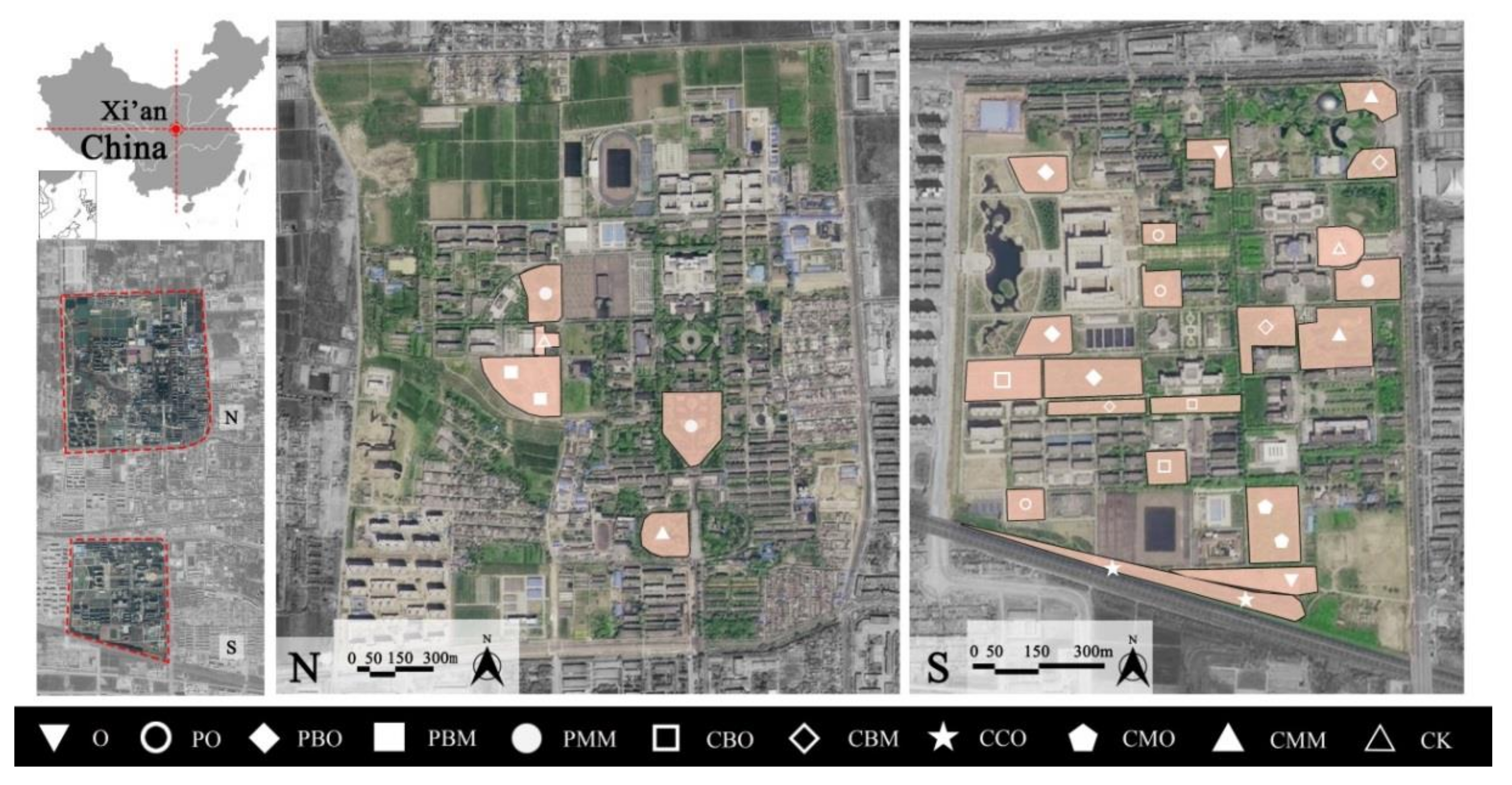
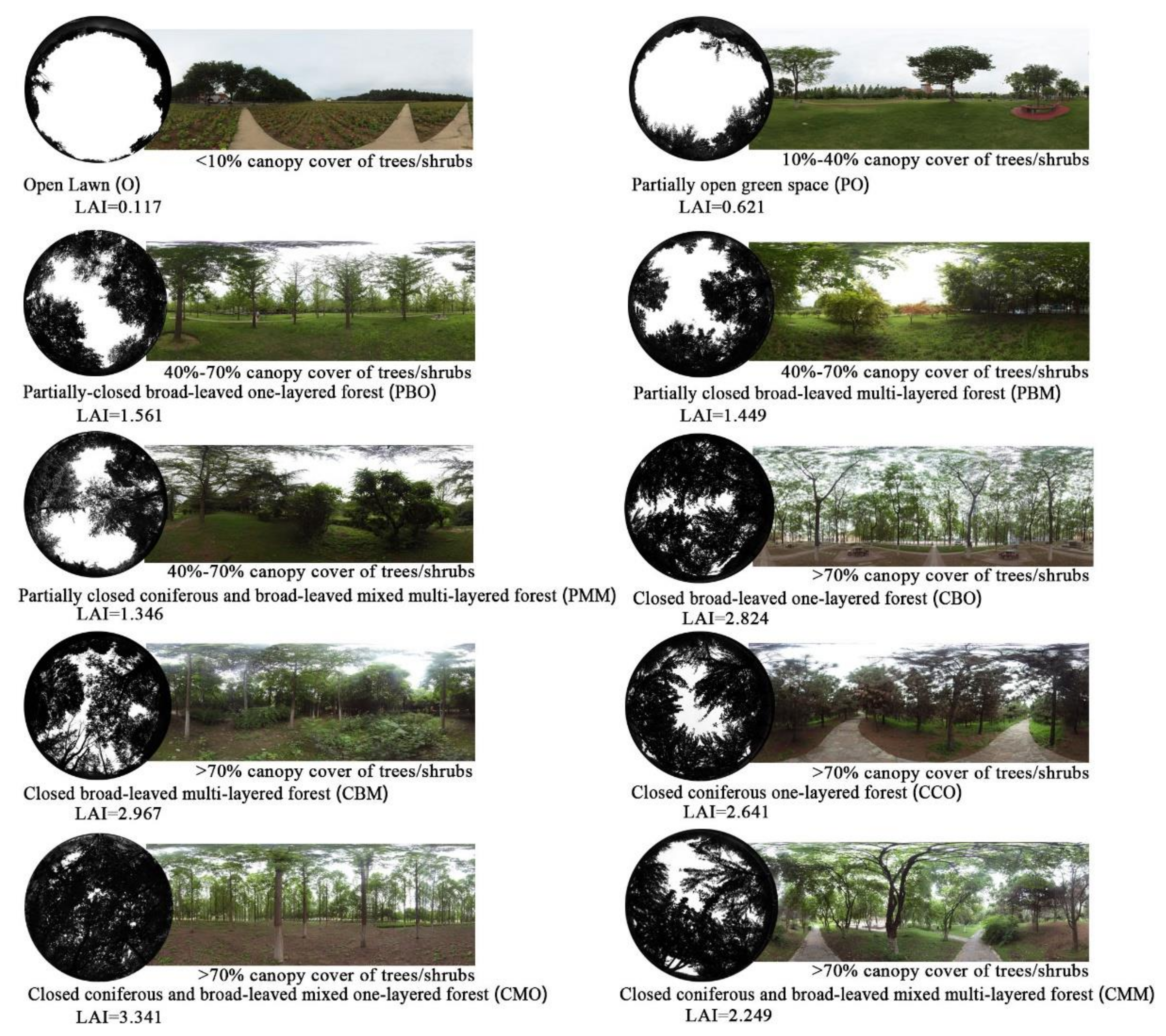
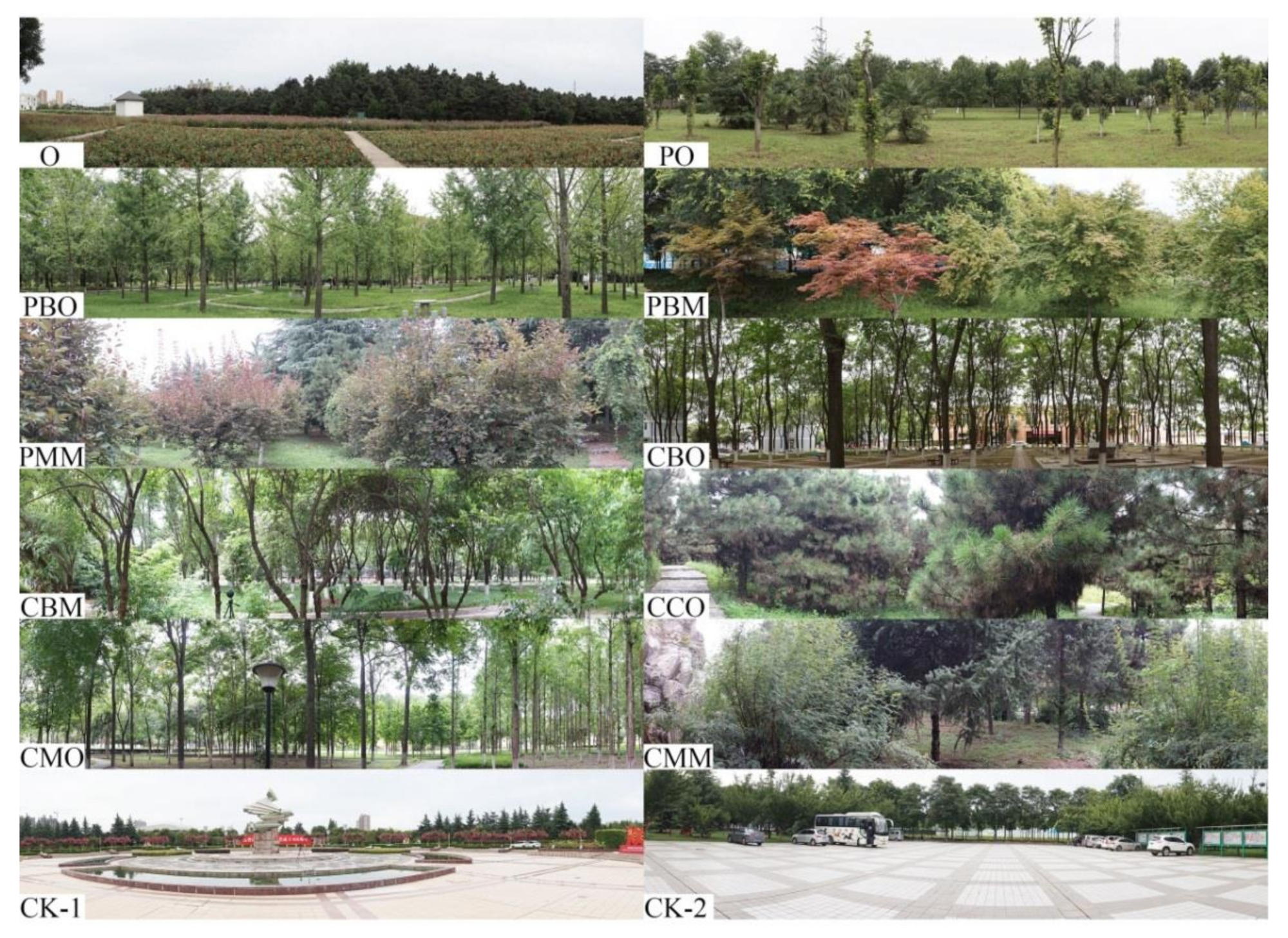
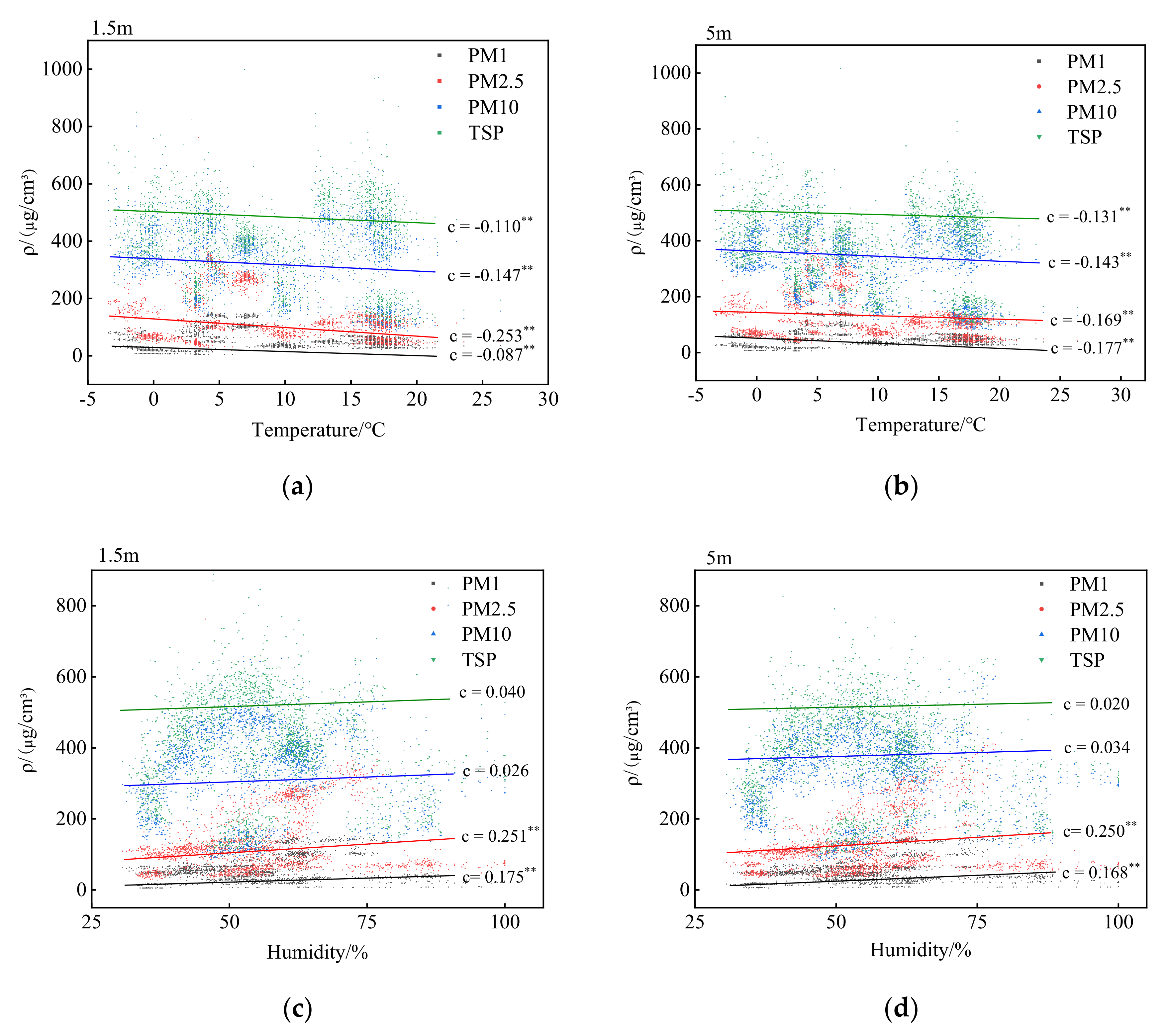
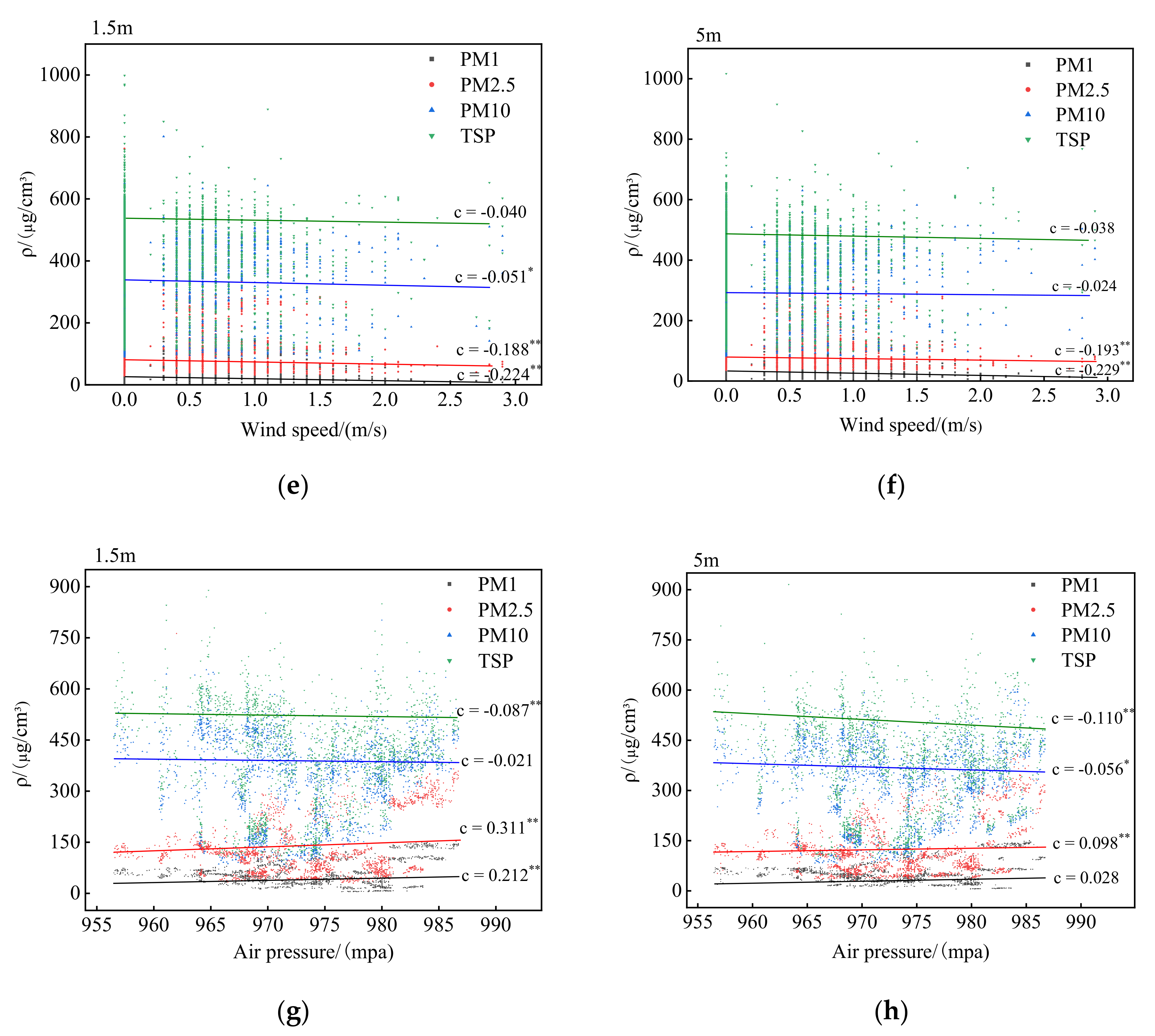


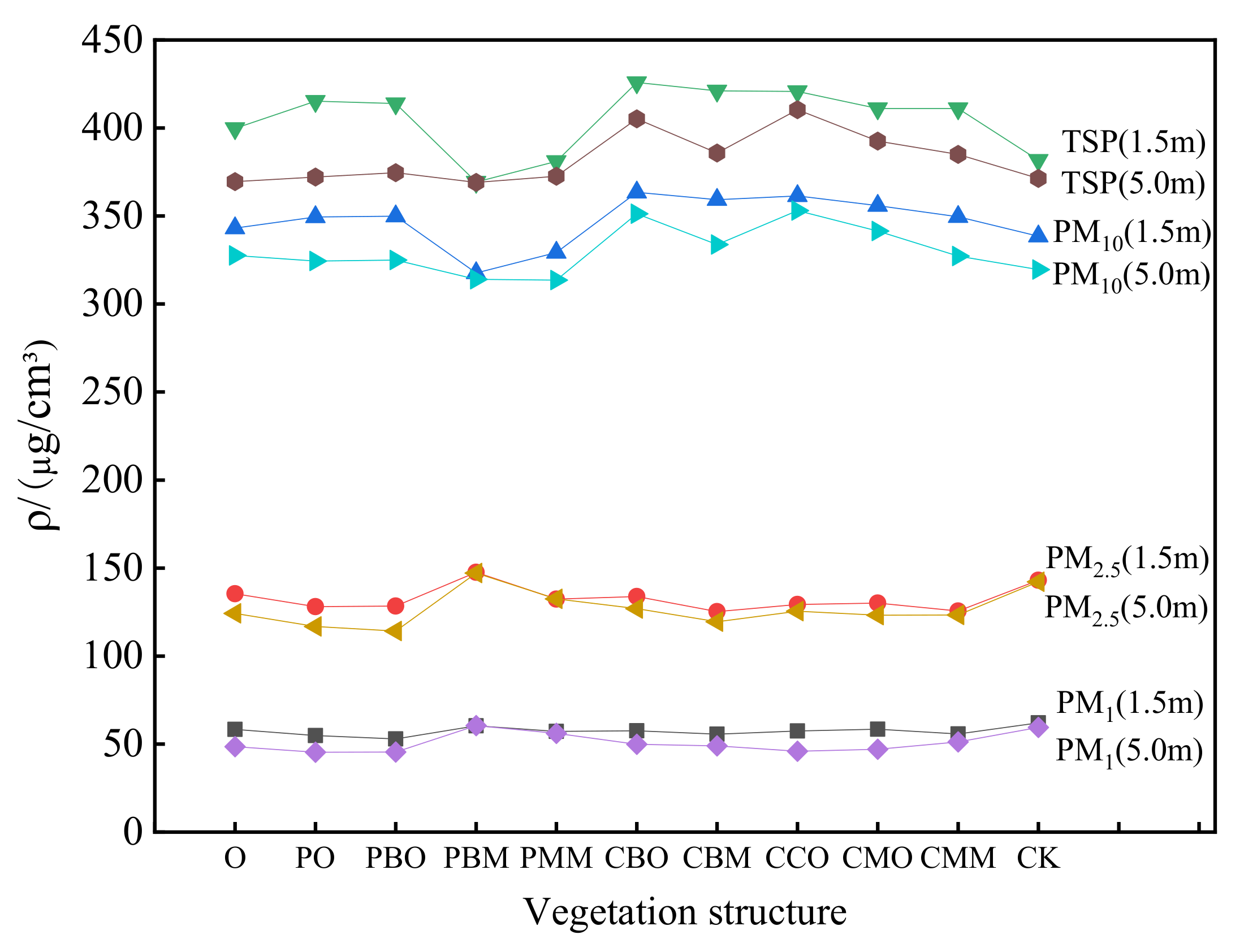
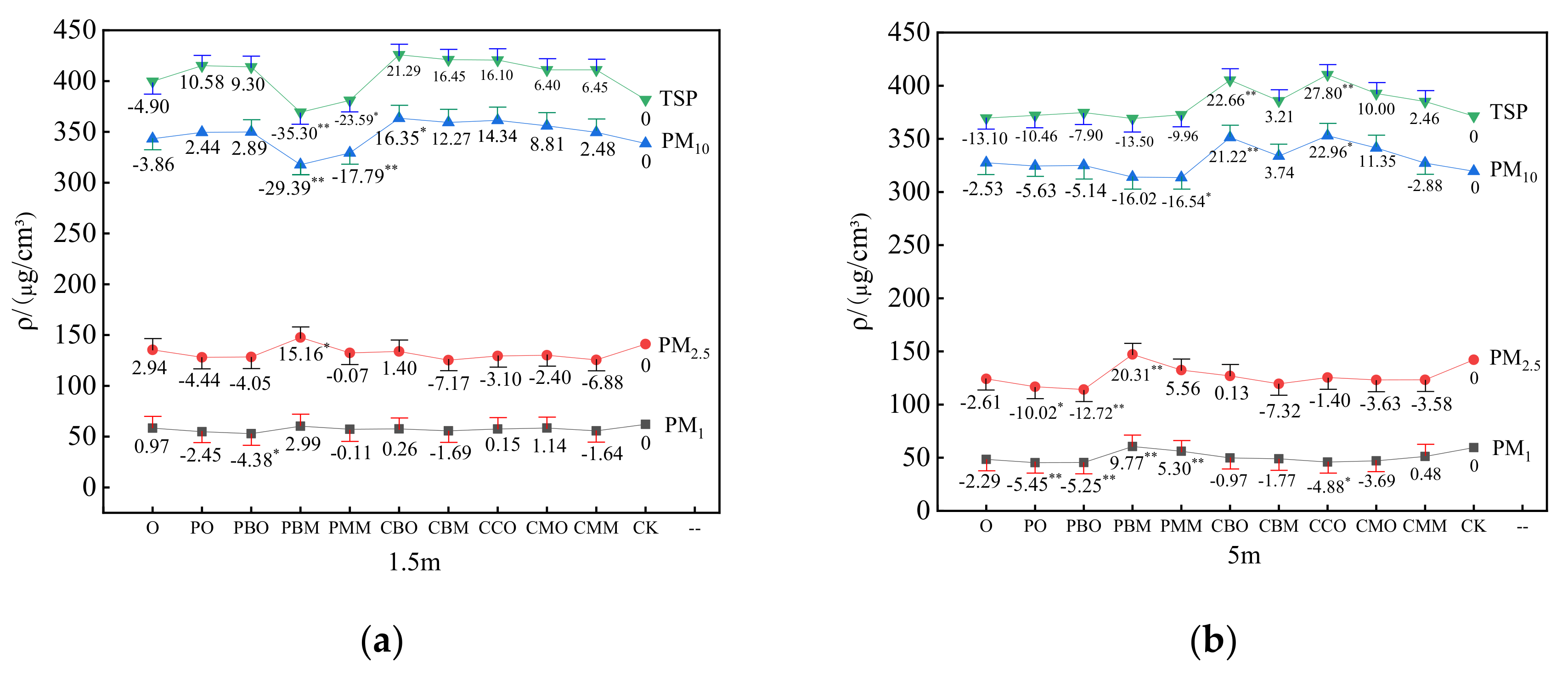
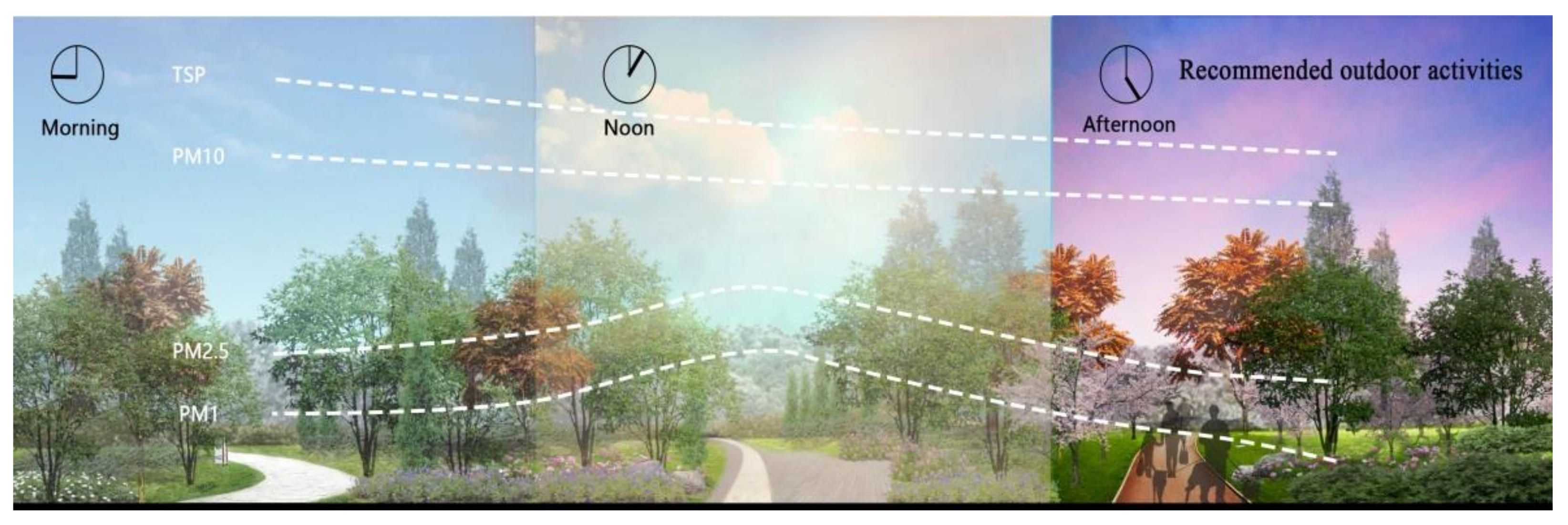
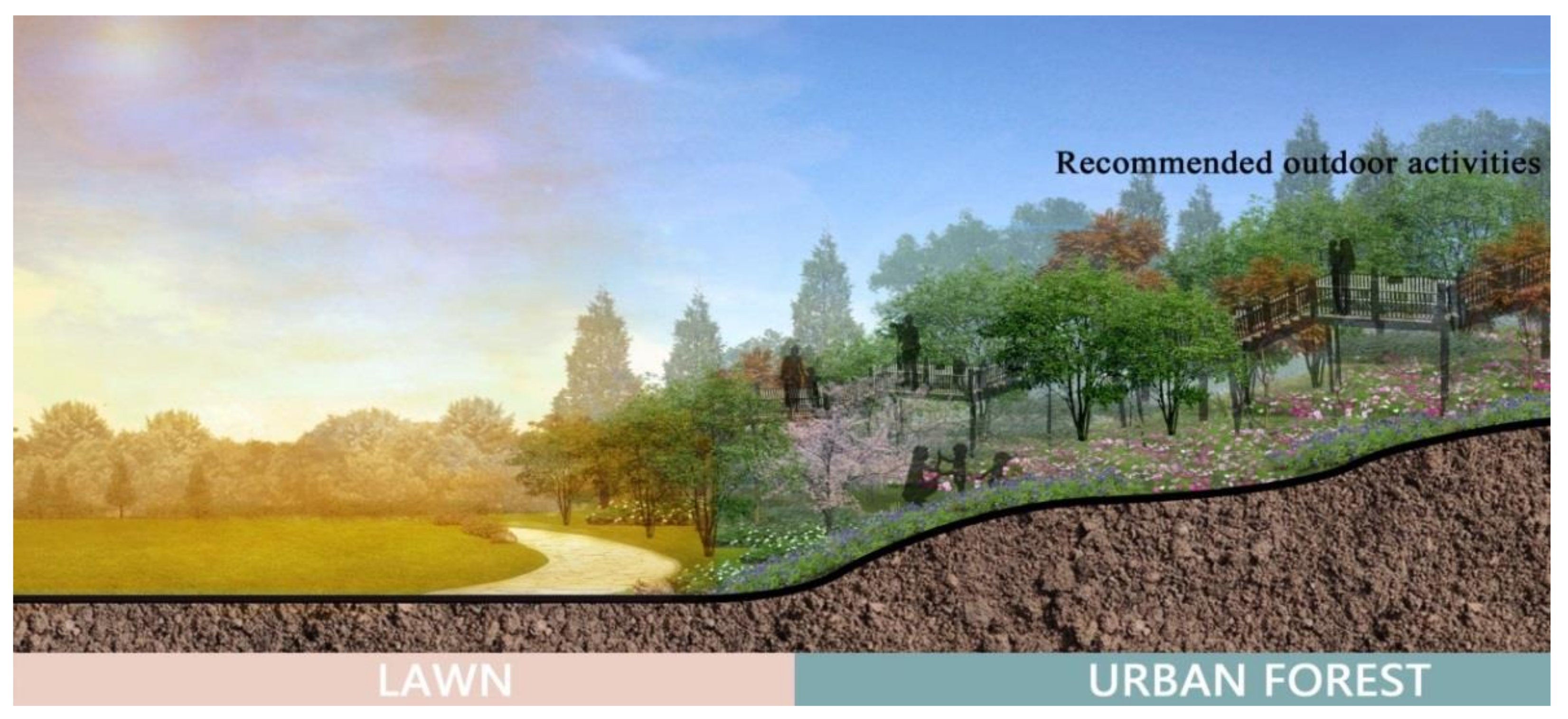
| Horizontal Structure | Species Composition | Vertical Structure | |
|---|---|---|---|
| Urban green spaces | Open green spaces (<10% canopy cover of trees/shrubs) | Lawn mainly dominated by Cynodon dactylon Grass flowers mainly dominated by Veronica persica | -- |
| Partially open green spaces (10–40% canopy cover of trees/shrubs) | Lawn mainly dominated by Arachis hypogaea Grass flowers mainly dominated by Oxalis corymbosa | ||
| Partially closed green spaces (40–70% canopy cover of trees/shrubs) | Broad-leaved trees mainly dominated by Melia azedarach Coniferous trees mainly dominated by Pinus tabuliformis Mixed plants mainly dominated by Ligustrum sinense and Cedrus deodara | One-layered Multi-layered | |
| Closed green spaces (>70% canopy cover of trees/shrubs) | Broad-leaved trees mainly dominated by Platanus orientalis Coniferous trees mainly dominated by Picea asperata Mixed plants mainly dominated by Koelreuteria paniculata and Platycladus orientalis | One-layered Multi-layered |
| Parameters | Df | PM1 | PM2.5 | PM10 | TSP | ||||
|---|---|---|---|---|---|---|---|---|---|
| F-Value | p-Value | F-Value | p-Value | F-Value | p-Value | F-Value | p-Value | ||
| Temperature | 1 | 2537.40 | 0.000 | 1979.89 | 0.000 | 2.88 | 0.090 | 38.45 | 0.000 |
| Relative humidity | 1 | 843.40 | 0.000 | 865.56 | 0.000 | 4.97 | 0.026 | 50.14 | 0.000 |
| Wind velocity | 1 | 247.26 | 0.000 | 224.79 | 0.000 | 9.12 | 0.003 | 5.73 | 0.017 |
| Air pressure | 1 | 7.42 | 0.006 | 4.79 | 0.029 | 1.43 | 0.023 | 2.16 | 0.142 |
| Pre-heating and heating periods | 1 | 3086.40 | 0.000 | 3245.85 | 0.000 | 8.56 | 0.003 | 4.81 | 0.028 |
| Monitoring time | 1 | 298.35 | 0.000 | 446.50 | 0.000 | 3.73 | 0.035 | 0.49 | 0.048 |
| Vegetation structure | 10 | 27.35 | 0.000 | 10.85 | 0.001 | 3.25 | 0.071 | 2.00 | 0.015 |
| Height | 1 | 74.24 | 0.000 | 10.97 | 0.001 | 23.96 | 0.000 | 29.34 | 0.000 |
| Height | Project | Spearman Correlation Test | |||
|---|---|---|---|---|---|
| Temperature (°C) | Humidity (%) | Wind Speed (m/s) | Air Pressure (mpa) | ||
| 1.5 m | PM1 (μg/m3) | −0.087 ** | 0.175 ** | −0.224 ** | 0.212 ** |
| PM2.5 (μg/m3) | −0.253 ** | 0.251 ** | −0.188 ** | 0.311 ** | |
| PM10 (μg/m3) | −0.147 ** | 0.026 | −0.051 * | −0.021 | |
| TSP (μg/m3) | −0.110 ** | 0.040 | −0.040 | −0.087 ** | |
| 5 m | PM1 (μg/m3) | −0.177 ** | 0.168 ** | −0.229 ** | 0.028 |
| PM2.5 (μg/m3) | −0.169 ** | 0.250 ** | −0.193 ** | 0.098 ** | |
| PM10 (μg/m3) | −0.143 ** | 0.034 | −0.024 | −0.056 * | |
| TSP (μg/m3) | −0.131 ** | 0.020 | −0.038 | −0.110 ** | |
Publisher’s Note: MDPI stays neutral with regard to jurisdictional claims in published maps and institutional affiliations. |
© 2021 by the authors. Licensee MDPI, Basel, Switzerland. This article is an open access article distributed under the terms and conditions of the Creative Commons Attribution (CC BY) license (https://creativecommons.org/licenses/by/4.0/).
Share and Cite
Jiang, B.; Sun, C.; Mu, S.; Zhao, Z.; Chen, Y.; Lin, Y.; Qiu, L.; Gao, T. Differences in Airborne Particulate Matter Concentration in Urban Green Spaces with Different Spatial Structures in Xi’an, China. Forests 2022, 13, 14. https://doi.org/10.3390/f13010014
Jiang B, Sun C, Mu S, Zhao Z, Chen Y, Lin Y, Qiu L, Gao T. Differences in Airborne Particulate Matter Concentration in Urban Green Spaces with Different Spatial Structures in Xi’an, China. Forests. 2022; 13(1):14. https://doi.org/10.3390/f13010014
Chicago/Turabian StyleJiang, Bo, Chang Sun, Sen Mu, Zixin Zhao, Yingyuan Chen, Yiwei Lin, Ling Qiu, and Tian Gao. 2022. "Differences in Airborne Particulate Matter Concentration in Urban Green Spaces with Different Spatial Structures in Xi’an, China" Forests 13, no. 1: 14. https://doi.org/10.3390/f13010014






